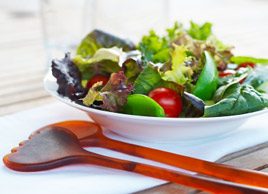How to choose a healthy salad
There are healthy salads, and then there are salads masquerading as healthy. Find out how to make sure yours meets your nutritional needs with these helpful tips

Source: Web exclusive: October 2009
I can’t help but push the nutritional envelope hard when it comes to making salads. I favour salad as a side dish for nearly every meal. The reasons for all this green boils down to the fact that we eat entirely too many cooked foods and rarely eat anything raw. A salad gives your body the alimentary opportunity to tackle a raw food and get those important enzymes, vitamins, and minerals so readily available from uncooked produce.
But in order to avail yourself of these nutrient-rich possibilities, it is necessary to understand what constitutes healthy when it comes to salad making. A pale hunk of iceberg lettuce with a goopy ladle of blue cheese dressing doesn’t cut it. And yet so many people think because they’ve eaten this "salad," they’re giving their bodies the nutrition it needs. Not true!
A good rule of thumb for evaluating a good salad should be colour. Colour is a great indicator of what’s ahead: good nutrition or near-empty calories. The more vibrant the colour, the healthier it is.
Let’s go back to that iceberg lettuce salad. It’s pale green and white. The iceberg lettuce’s value is mostly the water it carries. Fibre is minimal and nutrition almost nonexistent. The blue cheese is dripping with all kinds of fat so that X’s that off the list immediately. Let’s do a salad makeover, shall we?
First of all, you need to choose green. Green like spinach, salad bowl (Butter or Bibb), or romaine lettuces’all wonderful examples of what green should look like. The colour is there and so is the nutrition.
Look for red. Tomatoes come to mind. Vine ripened and full of vitamin C, tomatoes also contain the important phytochemical lypocene that helps fight cancer.
Orange or yellow? How about some colorful bell pepper or (when in season) summer squash? Carrots are fantastic sources for beta-carotene, a pre-vitamin for vitamin A. Beta-carotene has so many important functions, but the best part about beta-carotene is that it will convert into only as much vitamin A as the body needs, so there’s no worry about taking in too much. You know what happens if you have too much beta-carotene? You turn orange! My son was orange for the first and second years of his life’he loved sweet potatoes.
This is all common-sense nutrition here, but the point is to get you thinking next time you’re meandering your way through the produce section at the grocery store. Think in vivid, living colour’you need the nutrition!
Excerpted from Saving Dinner by Leanne Ely Copyright © 2003 by Leanne Ely. Excerpted by permission of Ballantine Books, a division of Random House of Canada Limited. All rights reserved. No part of this excerpt may be reproduced or reprinted without permission in writing from the publisher.




